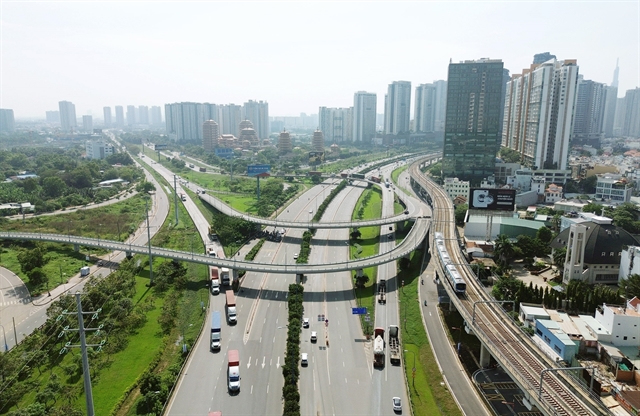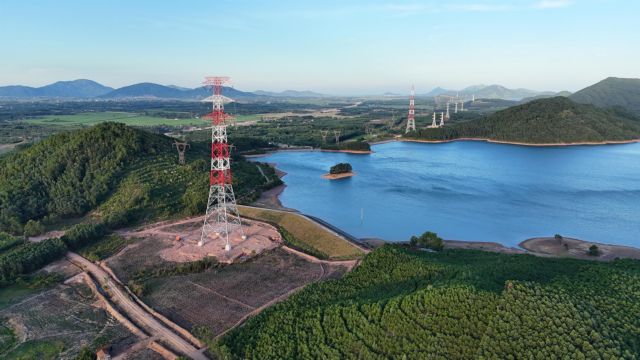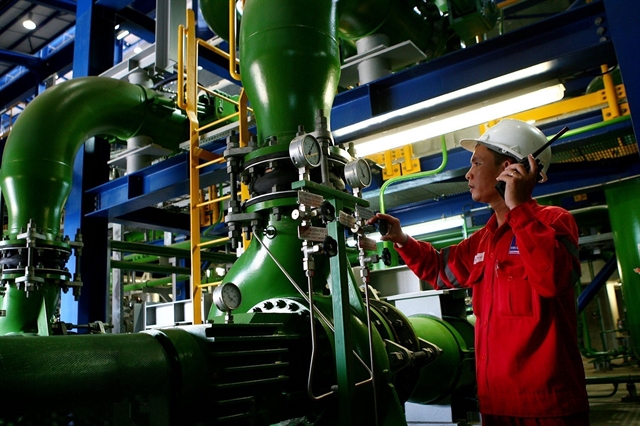With much higher economic growth targets set for the future along with a strong commitment to achieve net zero emissions by the end of 2025, Việt Nam is seeing growing demand for electricity.

Việt Nam is making bold efforts to ensure national energy security for robust socio-economic development and getting ready for 'the era of the nation’s rise', with focus on green and clean energy -- particularly an early resumption of a nuclear power project.
With much higher economic growth targets set for the future along with a strong commitment to achieve net zero emissions by the end of 2025, Việt Nam is seeing growing demand for electricity. This increases the risk of power shortages, as the development of power generation projects in the past five years has faced policy roadblocks.
Government statistics show that since 2021, just 56.7 per cent of planned power generation projects have been developed.
Meanwhile, Việt Nam is working towards robust economic growth. The National Assembly (NA) has set the economic growth target at more than 7 per cent for 2025. In an official dispatch issued in late December, Prime Minister Phạm Minh Chính even asked for more drastic efforts to achieve a growth rate of more than 8 per cent this year and two-digit growth rates from 2026 through 2030. Last year the growth rate was 7.09 per cent.
Addressing power shortages while undergoing socio-economic development will be a challenge for Việt Nam, requiring the country to create breakthroughs to achieve its economic growth targets and realise its goal of becoming a high-income country by 2045.
This requires the power supply to increase by 1.5 times, or up to 10,000MW must be added per year on average.
“This is a huge challenge. If there is no timely and quick solution to develop power sources, especially baseload power and green, clean and sustainable energy, there will be a potential risk of serious power shortages, especially from 2026 to 2028,” Prime Minister Chính noted in a directive issued on January 3 on solutions to ensure an adequate power supply for 2025 and for the next five years.
Việt Nam’s ambitions to accelerate the development of its digital and green economy are also adding significant pressure on the energy infrastructure and supply.
The country is aiming to attract foreign direct investment (FDI) into high-tech fields, especially semiconductors, which requires a substantial electricity supply.
The latest updates from the Việt Nam Foreign Investment Agency under the Ministry of Planning and Investment showed that disbursed FDI hit a record high of US$25.35 billion in 2024, rising by 9.4 per cent over the previous year.
By the end of 2024, the Government officially issued a long-awaited decree on the foundation, management and use of the investment support fund, with unprecedented incentives to attract investment from global technology giants to Việt Nam.
The country also made strong commitments to sustainability, requiring a drastic energy transition. At the 2021 United Nations Climate Change Conference (COP26), Việt Nam announced its goal to achieve net-zero carbon emissions by 2050.
At the heart of this goal, the ambition for green transport -- including the $67 billion North-South high-speed railway project expected to be powered entirely by electricity, urban metro systems and the adoption of electric vehicles -- will further weigh on the power infrastructure system.
A World Bank report on pathways for a transition to electric mobility in Việt Nam published last November pointed out that to meet rising EV charging demands, Việt Nam will need to increase its electricity generation by 5 per cent, and network capacity by 4 per cent by 2035. By 2050, these figures rise to 30 per cent for electricity generation and 15 per cent for transmission capacity, if the Government’s EV adoption targets for 2050 are fully achieved.
Việt Nam will need to invest up to $9 billion in additional power sector investments by 2030 to support EV growth and $14 billion a year between 2031 and 2050, according to the report.
Getting ready for the new era

Drastic measures are being taken to boost energy for the electricity industry.
The completion of a 500kV circuit 3 transmission line spanning 500km from Quảng Bình Province to Hưng Yên Province in only six months, the passing of the amended Law on Electricity, the decision to resume the nuclear power project, and amendments to the eighth national power development plan (PDP8) are major highlights in the recent effort to promote the development of the energy industry.
On November 30 last year, the NA passed the amended Law on Electricity. This important law was discussed and passed in only one NA session, demonstrating the determination to set out a framework for Việt Nam's energy security and carbon neutral goals, with the pressing question of how to ensure an adequate energy supply for rapid and sustainable socio-economic development.
The legislators on the same day gave the green light to restart the Ninh Thuận nuclear power project which has been postponed since 2016. Nuclear power is expected to meet the baseload electricity target to ensure energy security and help achieve net zero emissions.
Việt Nam is also accelerating changes to the PDP8 with a focus on developing nuclear power to become an important baseload power source, as the implementation of other power generation projects is stagnating due to policy bottlenecks.
For example, LNG-fired power projects are facing problems related to power purchase agreements (PPAs) and gas purchase agreements (GSAs), while offshore wind power has not been able to be implemented due to issues with marine spatial planning, making these electricity sources beyond reach.
Minister of Industry and Trade Nguyễn Hồng Diên has asked for efforts to speed up so that the amended PDP8 can be submitted to the Government for approval before February 28.
Spotlight on nuclear power
According to the existing PDP8, Việt Nam needs to expand its power capacity to 150,000MW by 2030 and up to 573,000MW by 2050, raising a pressing need for seeking a stable, trustworthy power source.
Currently, the baseload electricity source in Việt Nam includes coal-fired power or hydropower. Further development of these sources is not an option, as the country has committed to phasing out coal-fired power after 2030, while hydropower is basically running out of room for development.
Although solar and wind power are expected to be future sources of electricity, their lack of stability and heavy dependence on weather conditions mean that their contribution to the power system is limited.
In this context, nuclear power is seen as a strategic solution to achieve two goals: ensuring energy security and reaching net zero emissions by 2050, Minister of Science and Technology Huỳnh Thành Đạt has said.
Nuclear power is known for being emission-free, and also provides a stable baseload electricity, which is vital to accelerate the energy transition process.
Trần Chí Thành, director of Việt Nam Atomic Energy Institute, has noted that a number of countries in the world are accelerating their net zero goals through nuclear power programmes, and regard it as a core solution to reducing greenhouse gas emissions.
Statistics from the International Atomic Energy Agency's Power Reactor Information System (PRIS) show that nuclear power contributes nearly 10 per cent of the world's total electricity output and one fourth of its low-emissions power output.
At COP28 in December 2023, 198 countries called for the acceleration of low-emissions energy technology, including nuclear power, to achieve carbon neutrality by 2050. More than 20 countries committed to tripling their nuclear power output.
By the end of August 2024, there were 415 operational nuclear reactors worldwide with a combined capacity of 373,735MW, along with an additional 62 reactors under construction with a total capacity of approximately 64,970MW.
“If Việt Nam does not develop nuclear power, the country might not be able to meet the increasing demand for energy. Baseload nuclear power plants will replace coal-fired thermal power to help significantly reduce greenhouse gas emissions,” Trần Văn Bình of the Hà Nội University of Science and Technology said.
As planned, the two nuclear power plants will be developed in Ninh Thuận with modern technology to ensure the utmost safety.
In a bold move, Prime Minister Chính has asked for the building of the Ninh Thuận nuclear power project to be completed within five years.
Driving progress

In an effort to ensure a stable power supply over the next few years, the Prime Minister asked the Ministry of Industry and Trade to focus resources and speed up the progress of major power generation and transmission projects.
The selection of investors for power generation projects in PDP8 including LNG Nghi Sơn, LNG Quỳnh Lập and LNG Cà Ná must be completed in the second quarter of this year, so that these projects can be completed by the third quarter of 2028.
For power generation projects that are expected to be completed this year, the Prime Minister requested that progress be sped up to put these projects into operation three to six months earlier than scheduled. These include the Nậm Củm 4 hydropower plant, the expanded Hoà Bình hydropower plant, LNG Nhơn Trạch 3 and 4, Vũng Áng 2 and Quảng Trạch 1.
The Prime Minister also asked to complete projects that are scheduled to go operational over the next five years 1-2 years early.
With regard to Nhơn Trạch 3 and 4, he asked the Việt Nam Oil and Gas Group (PVN) to mobilise all resources to speed up their progress for commercial operation in June 2025. This means that Việt Nam will have its first LNG plant in the next few months.
The pilot implementation of offshore wind power must also be carried out in 2025, he said.
Efforts must be made to hasten the implementation of transmission projects, including for Nhơn Trạch 3 and 4, the 500kV Lào Cai-Vĩnh Tân and Monsoon-Thạch Mỹ lines to transmit imported power from China and Laos to northern Việt Nam, in case import is needed.
The Prime Minister also asked that there be no fuel shortages at thermoelectric plants. VNS





